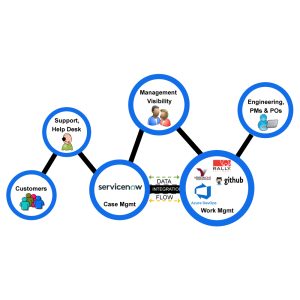Managing enterprise assets across multiple locations is no small feat. With various facilities, teams, and workflows, ensuring operational efficiency while maintaining consistency can be challenging. IBM Maximo, a leading Enterprise Asset Management (EAM) solution, provides a robust framework for managing assets across multiple sites. However, deploying Maximo at scale requires careful planning and strategic execution.
This blog explores best practices for multi-site deployments in IBM Maximo, focusing on scalability, standardization, and operational efficiency.
Understanding the Complexity of Multi-Site Asset Management
Enterprise Asset Management (EAM) in a single facility is already a complex task. When expanded across multiple sites, the complexity increases exponentially. Organizations must account for:
- Diverse Asset Types – Different locations may house distinct types of equipment, each requiring unique maintenance strategies.
- Regulatory Compliance – Compliance requirements vary by region, industry, and asset class.
- Workforce Coordination – Ensuring teams across multiple locations follow standardized maintenance and operational procedures.
- Data Consistency – Uniform data structures and reporting methodologies are critical for effective decision-making.
Implementing IBM Maximo in such an environment requires a structured approach to avoid operational silos and inefficiencies.
Best Practices for Multi-Site Deployments in IBM Maximo
1. Establish a Centralized Governance Framework
A successful multi-site Maximo deployment starts with strong governance. Organizations must define clear policies and structures to ensure uniformity across all locations. This includes:
- Defining Roles and Responsibilities – Assign clear ownership for Maximo configuration, maintenance, and updates at both the corporate and site levels.
- Standardized Workflows – Ensure consistency in work order management, preventive maintenance, and inventory control.
- Approval and Change Management – Establish change control processes to prevent uncoordinated modifications that may impact data integrity.
A well-defined governance structure prevents misalignment and ensures that all locations operate under the same best practices.
2. Standardize Asset Data and Classification
One of the most significant challenges in multi-site deployments is data inconsistency. Without standardization, reporting and analysis become unreliable. To address this:
- Develop a Unified Asset Hierarchy – Use a common classification system for all assets, ensuring consistent tracking and reporting.
- Standard Naming Conventions – Create uniform naming standards for assets, locations, and work orders.
- Centralized Master Data Management – Maintain a single source of truth for asset information across all sites to avoid duplication and discrepancies.
By standardizing asset data, organizations can improve visibility and streamline decision-making.
3. Leverage Multi-Site Configurations in Maximo
IBM Maximo offers built-in capabilities to support multi-site operations efficiently. Key features include:
- Organizations and Sites Configuration – Maximo allows organizations to define multiple sites within a single deployment while maintaining centralized control.
- Shared and Site-Specific Data – Organizations can configure shared asset records, inventory, and vendors while allowing site-specific variations where necessary.
- Security and Access Control – Implement role-based access to ensure that users can only interact with data relevant to their specific locations.
Configuring Maximo effectively reduces redundancy and ensures seamless data sharing across sites.
4. Optimize Work Order and Maintenance Processes
For enterprises with multiple locations, work order execution and maintenance workflows must be standardized yet flexible enough to adapt to site-specific requirements. Best practices include:
- Implementing Preventive and Predictive Maintenance – Reduce downtime by setting up automated maintenance schedules and leveraging AI-driven insights.
- Cross-Site Work Order Management – Enable collaboration between locations to allocate resources more efficiently.
- Mobile Access for Technicians – Equip field teams with mobile Maximo applications to update work orders, report issues, and access asset history in real-time.
A well-optimized maintenance strategy ensures asset longevity and operational continuity.
5. Integrate IoT and AI for Smarter Asset Management
Modern enterprises are moving beyond reactive maintenance by integrating IoT sensors and AI-powered analytics into Maximo. This enables:
- Real-Time Asset Monitoring – IoT devices provide real-time insights into equipment performance and potential failures.
- AI-Driven Predictive Maintenance – Machine learning models analyze historical data to predict asset failures before they occur.
- Automated Alerts and Workflows – Maximo can automatically generate work orders based on sensor data, ensuring timely interventions.
Incorporating IoT and AI into Maximo enhances operational efficiency and minimizes unexpected downtime.
6. Streamline Inventory and Spare Parts Management
Inventory management in a multi-site environment requires careful coordination to prevent overstocking or shortages. To achieve this:
- Centralized vs. Decentralized Inventory Management – Determine which parts should be managed centrally and which should be stocked at local sites.
- Automated Inventory Replenishment – Use Maximo’s inventory tracking and procurement features to maintain optimal stock levels.
- Inter-Site Inventory Sharing – Enable asset and part sharing across locations to reduce procurement costs and improve resource utilization.
Efficient inventory management reduces costs while ensuring that critical spare parts are available when needed.
7. Conduct Regular Training and Continuous Improvement
A well-implemented Maximo deployment is only as effective as the teams managing it. To ensure long-term success:
- Ongoing Training Programs – Keep teams updated on Maximo’s capabilities, new features, and best practices.
- User Feedback Loops – Gather feedback from site operators and maintenance teams to identify improvement areas.
- Performance Benchmarking – Use Maximo’s analytics to track performance across sites and implement continuous process improvements.
Regular training and evaluation help maximize the value of the Maximo deployment.
Final Thoughts: Scaling EAM with Nexright
Scaling IBM Maximo for multi-site enterprise asset management requires a well-structured approach, balancing standardization with site-specific flexibility. From governance and data consistency to predictive maintenance and AI-driven automation, a strategic Maximo deployment can significantly enhance operational efficiency.
At Nexright, we specialize in helping enterprises unlock the full potential of IBM Maximo through tailored implementation, integration, and optimization strategies. Our expertise ensures that businesses achieve seamless multi-site asset management with improved reliability, compliance, and cost efficiency.
Ready to scale your IBM Maximo deployment? Partner with Nexright today and take your enterprise asset management to the next level.




